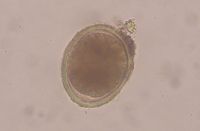Difference between revisions of "Toxocara cati"
(No difference)
| |
Latest revision as of 17:47, 4 June 2016
| Toxocara cati | |
|---|---|
| Class | Nematoda |
| Super-family | Ascaridoidea |
Also known as: Toxocara mystax
Introduction
Toxocara cati is a nematode of the superfamily Ascaridoidea. T. cati is found worldwide, and can cause a wide range of gastrointestinal problems in infected hosts.
There is a zoonotic risk with ingestion of larvated eggs, which can produce the conditions of visceral larval migrans and ocular larval migrans in humans. However T. canis is the more common culprit.
Hosts
Cat
Identification
T. catis is a large white worm. The female is capable of growing up to 10cm in length. The male, similar to Toxocara canis, has a finger-like process on the tip of the tail.
The eggs are approximately 70μm, have no distinct colour, but have a thick, pitted outer shell.
Life Cycle
The adult worms live in the small intestine and the females produce eggs that are passed in the faeces of the cat.
Infection occurs by ingestion of the L2 in the egg, or after ingestion of a paratenic host, or via transmammary route.
After direct ingestion of the larvae, they migrate through the liver, lungs and trachea, and then go back to the small intestine, where they transform into L3.
Ingestion of a paratenic host like a mouse causes the larvae to be released by digestion, and they then enter the small intestine of the cat, and will moult into L3.
Transmammary infection is also very important, and commonly seen throughout lactation. However, unlike T. canis, prenatal infection does not occur.
The prepatent period of T. catis is 8 weeks.
Clinical Signs
Infected kittens will present with stunted growth and a loss of condition. Their coat may be dull and they may appear 'pot-bellied'.
Worms may be seen in vomitus or in the faeces.
Migrating larvae can cause damage to internal organs leading to pneumonia and coughing, ascites, fatty liver.
Diagnosis
Infection is diagnosed by finding eggs in the faeces of the animal, using faecal flotation methods.
Toxocara leonida eggs may confuse the diagnosis, but they are smooth-shelled and more oval in shape.
Treatment and Control
Treatment of gastrointestinal infections with Toxocara cati is relatively straightforward. Anthelmintics such as febantel, pyrantel, selamectin, fenbendazole and milbemycin can be used.
It may be possible to prevent transmammary transmission of the larvae by using targeted administrations of fenbendazole just before delivery of the kittens, but no trials have been performed yet.
Kittens should be presumed to be infected at birth, and should be treated accordingly.
The main form of control is to prevent cats from obtaining infections by preventing access to paratenic hosts such as mice and other rodents and preventing access to eggs by promptly identifying and treating patent infections.
People, particularly children, should adhere to strict hygiene rules when in areas that may have been contaminated by infected animals.
| Toxocara cati Learning Resources | |
|---|---|
To reach the Vetstream content, please select |
Canis, Felis, Lapis or Equis |
 Test your knowledge using flashcard type questions |
Feline Medicine Q&A 09 |
 Search for recent publications via CAB Abstract (CABI log in required) |
Toxocara cati publications |
References
Bowman, D. (2002) Feline Clinical Parasitology Wiley-Blackwell
Foreyt, W. (2001) Veterinary parasitology reference manual Wiley-Blackwell
Merck and Co (2008) Merck Veterinary Manual Merial
| This article has been peer reviewed but is awaiting expert review. If you would like to help with this, please see more information about expert reviewing. |
Error in widget FBRecommend: unable to write file /var/www/wikivet.net/extensions/Widgets/compiled_templates/wrt677f9b40eac7e4_53064105 Error in widget google+: unable to write file /var/www/wikivet.net/extensions/Widgets/compiled_templates/wrt677f9b40f00d21_09686705 Error in widget TwitterTweet: unable to write file /var/www/wikivet.net/extensions/Widgets/compiled_templates/wrt677f9b41009816_72488405
|
| WikiVet® Introduction - Help WikiVet - Report a Problem |
